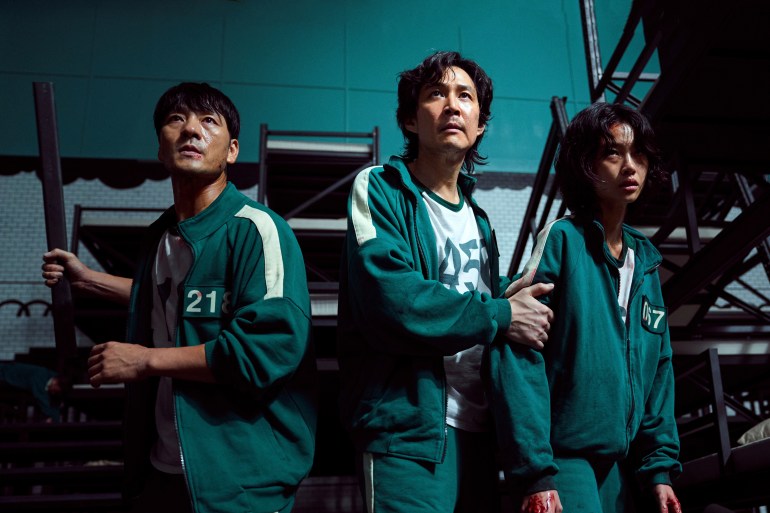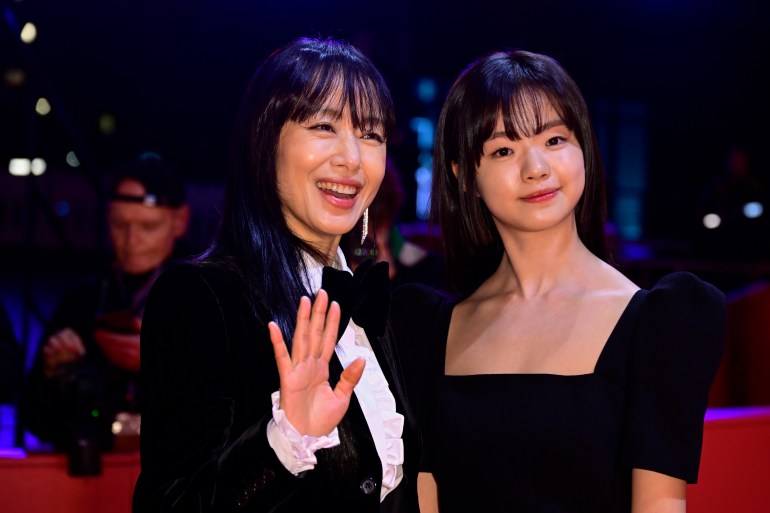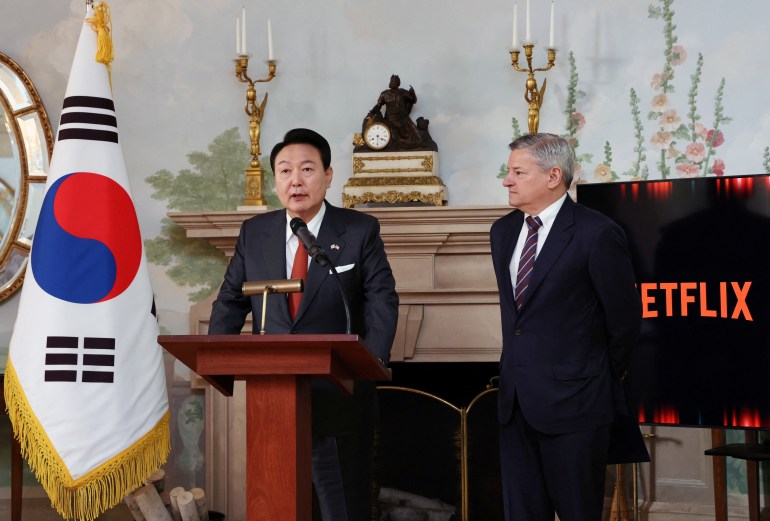Will the Korean drama wave rise higher — or could it crash?
What do a devastating zombie virus, a brilliant lawyer with Asperger’s Syndrome, high school bullying, and children’s games with deadly twists have in common? They are the themes underpinning four of Netflix’s 10 most-watched non-English shows — ever.
They are also all in Korean.
Nearly a quarter of a century after journalists at the Beijing Youth Daily coined the term ‘Korean Wave’ (or ‘Hallyu’), startled by the growing popularity of South Korean entertainment exports in China and across Asia, that trend has exploded globally.
From Iraq to India, and Mexico to Morocco, Korean dramas have captivated audiences, bringing in billions of dollars in investments for the production of more such shows. Some researchers have recently suggested that K-dramas represent “a significant contraflow to Western-dominant transnational pop culture”.
Nothing captured their international appeal like the stunning success of Squid Game, the 2021 show about a contest in which people desperately in need of cash participate. The competition involves a series of games. Those who win each game advance to the next; those who lose die. Squid Game was an undisputed winner, and is Netflix’s most-watched series.
The rise and rise of such shows comes amid a wave of popularity that Korean culture is riding move broadly — from K-pop music and bands like BTS to Oscar-winning films like Parasite.
But what is the secret sauce turning K-dramas into blockbuster hits across the globe? And what does the future hold?
The short answer: Like a good K-drama script, it is complex. To a large extent, say experts, it might boil down simply to high-quality storytelling, smartly delivered in a way that works across geographies and resonates with women in particular. Streaming platforms like Netflix have also taken K-dramas to audiences that might never have otherwise seen them. But this model of growth has limitations — and unless South Korea’s creative industry is careful, it could stifle the very dreams it is spawning.

‘Just good’
There’s no one “element of formula” behind the success of K-dramas globally, said Areum Jeong, an expert of Korean popular culture and incoming assistant professor of Korean Studies at Arizona State University.
Instead, she told Al Jazeera, a set of factors is driving this wave. They include: “Sociocultural issues packaged in an entertaining story, skilful acting and design, an accessible platform that allows millions to view, and a message that resonates with the audience.”
But all of that depends on an even more central attribute that is allowing these shows to flourish, said Gi-Wook Shin, director of the Korea Program at Stanford University — the quality of storytelling.
“I think it’s important to recognise that the content in these dramas is just good,” said Shin. “Korea has gotten good at telling stories about topics people care about in ways that grab viewers’ attention and keep them hooked.”
Many of the shows have universal messages that appeal to international viewers despite featuring issues that are specific to Korean culture and society.
“For example, Squid Game represents socioeconomic inequalities, competition for resources, aspiring upward mobility, power dynamics between different races and genders that affect not only South Korea, but also other parts of the globe as well,” Jeong said.
By deploying thoughtful, character-led and human stories — a trend that spans both K-dramas and Korean films — producers and directors are able to break language barriers. Parasite, which became the first non-English film to win the Oscar for Best Picture in 2020, struck a chord with viewers through its sharp storytelling, which focussed on issues of inequality, poverty and class struggle.
“The human emotions in these dramas are very detailed,” said Hyun Jung Stephany Noh, a PhD candidate at the Department of Radio-Television-Film at the University of Texas who focuses on the Korean cultural wave.
At the same time, K-dramas offer a bouquet of themes that might interest different Korean and global audiences. Whether it is romance, thrillers, horror, death games, adventure, comedy, action, war, fantasy or science fiction — there is a good K-drama to suit the taste.
“The success of Korean cultural content is for different reasons in different places,” Shin told Al Jazeera. It could be a social and cultural connection in India or Latin America, traditionally conservative societies grappling with rapid change, for instance. “K-dramas have some similarities to Indian Bollywood or Latin American telenovelas, so it is not really surprising that K-dramas have become successful in these places,” he said. “The US is also increasingly diverse and intent on valuing diverse cultures and experiences, which K-dramas offer.”
While Squid Game offers a brutal critique of late-stage capitalism, The Glory — the fifth-most watched non-English show in Netflix history — addresses the issue of school bullying in South Korea. All of Us are Dead, which ranks fourth in that list of chart-toppers, is about a zombie virus outbreak at a high school. Extraordinary Attorney Woo, at number seven, is about a young lawyer with Asperger’s Syndrome who struggles with daily interactions but is brilliant in her field and far more emotionally intelligent than many of her legal peers.
Just as audiences search for shows they might like the best, so do the makers of K-dramas hunt for new themes, Noh said. “Nobody knows what the next big hit is. But they’re always looking for something new, they are always experimenting to make that next big show,” she said.

The gaze and the look
For all the diversity and global appeal of the content, there is a clear method at play with K-dramas that helps distinguish them from potential rivals, including for instance, US soaps.
Korean rom-com dramas in particular have become successful worldwide because “they do a uniquely good job of catering to female audiences and depicting life and love from a female view in a way that content from other countries — like America — does not,” said Shin.
It is a sentiment echoed by Noh: “Romance-based series are popular internationally because they are working for the female gaze, whereas Hollywood, for example, is more about the male gaze,” she told Al Jazeera.
In some ways, that is not surprising. An overwhelming majority of scriptwriters in the Korean drama industry are women who are involved in the production of shows across a wide variety of genres. According to some estimates, the number of female screenwriters in Korea is close to 90 percent, whereas in the United States, only 27 percent of all directors, writers, producers and other production staff on network programs are women.
There is another reason too that Korean shows do well globally, said Shin. “K-dramas tend to be very visually appealing,” he said. “They’re fun to look at, and they pay attention to aesthetic details in a way that American series generally do not.” He cited the example of the costumes of the guards and participants in Squid Game: The matching green tracksuits worn by the contestants are a distinctive element in the series. In direct contrast to them, the guards are clad in red jumpsuits and eerie fencing masks. These costumes became so popular that they have dominated Halloween for two years in a row since the series aired.
“[The costumes in Squid Game] are visually arresting and instantly recognisable. Wealthy characters in dramas like The Glory are dressed to the nines,” he said.
And the quality of the productions is poised to only improve as global investors queue up to pump money into K-dramas. “The industry itself is growing and the production companies are growing in size,” Noh explains. “And it’s a very vibrant, creative industry. It’s also very competitive, which is another reason why these productions look so good.”
Japanese firms were early investors, followed by their Chinese counterparts. Leading the way, Chinese streaming platform iQIYI demonstrated just how profitable such investments could prove: It secured the broadcast license for the popular Korean series My Love from the Star for about $600,000 and earned more than $100m in revenue.
Seeing that success, other Chinese investors followed, bankrolling production costs for shows and even buying majority stakes in Korean production houses like Chorokbaem Media and Kim Jong-hak Production.
But those forays pale in comparison with the new dominant force shaping K-dramas: Netflix.

The Netflix dilemma
Over the years, “streaming platforms that guarantee easy access for global audiences” have played a vital role in the growing popularity of Korean cultural exports outside the country, said Jeong.
Since launching its Korean service in 2015, Netflix has led that trend, with approximately 232.5 million paid subscribers worldwide. “Right now, Netflix is the catalyst to make Korean dramas more visible and more accessible,” said Noh.
It has also emerged as a major investor in the country’s drama industry and pays Korean companies 110 percent of their production budget for original content — in effect covering all their production costs and then some.
And the streaming platform is doubling down on its bet on these shows. Last month, it announced that it would invest $2.5bn in Korean content over the next four years after a meeting between co-CEO Ted Sarandos and South Korean President Yoon Suk-yeol, up from the $460m it spent on K-dramas in 2021.
Korean productions now have more money to refine their quality. Netflix spent $1.7m per episode on 2019’s Kingdom, the platform’s first Korean original series, about a prince who must save his people. That budget went up to $2.4m per episode for Sweet Home, released in December 2020.
As iQIYI discovered, the profits from the stunning success of Korean shows for such investments are exponentially larger. “For something that successful, if you produced that in Hollywood, the production costs would be much higher,” said Noh.
But that growing dependence on Netflix has downsides too, warned researchers Ji Hoon Park, Kristin April Kim and Yongsuk Lee at Korea University in a paper published in the peer-reviewed International Journal of Communication earlier this year. The platform, they cautioned, could monopolise the global streaming rights to most big-budget Korean drama series because their production “is now unfeasible without Netflix’s investment”.
Netflix’s involvement has increased the salaries of South Korean writers, directors, actors and actresses to levels that production firms might now struggle to meet without continued investments from the streaming service. The US company’s financial dominance could also weaken Korean domestic TV stations and platforms, further strengthening Netflix’s monopoly, the Korea University researchers said.
“Because Netflix acquires all IP rights to Netflix Korean originals and the global streaming rights to numerous Korean dramas,” wrote the Korea University researchers, “neither production companies nor Korean television stations gain profits commensurate with the global popularity of Korean dramas.”
And because of the large gap between the costs of production and the profits from the global popularity of K-dramas, Netflix benefits much more than even the local production companies it partners with, which are “still under-compensated,” said Noh.

The road ahead
So will the Korean wave peak and then crash? That question is not new.
In the mid-2000s, the export of K-dramas — after some stunning success — dropped amid a protectionist backlash from the entertainment industries of major markets. One of China’s top television actors, Zhang Guoli, branded the K-drama wave a ‘cultural invasion’. Actor Jackie Chan called on domestic Chinese audiences to ‘resist’ Korean shows and consume domestic products instead.
But in 2009, it returned in a reinvented form and even expanded to films, musicals and pop music, as well as geographically. Central to the success of the second generation of the Korean Wave — or ‘Hallyu 2.0’ — was that it no longer depended on satellite television channels as intermediaries. Instead, this wave was now driven mainly by social media and the internet, rather than satellite broadcasts. K-dramas became available online and with subtitles, and clips of K-pop performances were shared widely on the internet, broadening the scope of South Korean cultural exports.
Nor are the risks posed by a Netflix hegemony over the sector unfamiliar to the South Korean entertainment industry. By the early part of the last decade, Japan was a key market for K-dramas. But tensions rose between Seoul and Tokyo during South Korean President Lee Myung-bak’s administration from 2008 to 2013, especially after he visited islands claimed by both nations.
As Korean drama sales in Japan fell, China emerged as an alternative market — only to crash again when ties between Seoul and Beijing suffered after South Korea ignored Chinese concerns about installing a US-made missile defence system. Like the entertainment sector globally, the K-drama industry too struggled during COVID-19, when productions had to be halted.
But the stunning reemergence of Korean serials as global blockbusters since then underscores the resilience of an industry that has bounced back from multiple economic and geopolitical setbacks.
“The Korean Wave did not come out of a vacuum and the industry has been creating unique content for more than three decades,” said Jeong.
Still, challenges remain. The global limelight on Korean pop culture has also sparked an increase in what Jeong called “critical discussion” about issues the country’s entertainment industry needs to address.
“As South Korea’s cultural products take the world by storm, there is also much to talk about,” said Jeong. “For instance, how can South Korean works promote more inclusivity in gender, race, and sexuality? There is a need for more narratives that centre social minorities and the industry should be more sensitive about keeping up with discourses on cultural appropriation and racism.”
The K-pop industry offers a glimpse into a darker side of Korean entertainment that could also affect Korean dramas, though likely not to the same extent, suggested Shin. Many K-pop idols have died by suicide, pointing to a mental health crisis. Agencies maintain strict control over young stars — some of whom debut as young as at the age of 13. They are subject to sexualisation at a young age and are sometimes not allowed to even date, let alone speak up on contentious global issues, he said.
South Korea’s mandatory male conscription of between 18 and 22 months also disrupts the careers of entertainers, Shin said.
And both the K-pop and K-drama industries suffer from a narrow understanding of beauty and inadequate respect for diversity, according to Shin.
“In South Korea there is a very strict standard for what constitutes attractiveness, which is in stark contrast to efforts in the West to embrace different skin colours and body shapes,” he said. “K-dramas’ global appeal may not last if they espouse one stringent standard of beauty to diverse audiences that do not conform to that standard.”
To be sure, K-dramas have begun to open up more, Shin said, citing the example of Extraordinary Attorney Woo.
“Yet the industry could still stand to think about how it can improve along these lines,” he says. “It is still rare, for example, to see a gay character in a K-drama, because homosexuality is still somewhat taboo in Korean society.”
That might need to change if Korean shows are to maintain one of their traditional strengths — mirroring social and cultural debates that resonate globally. The world is watching them, quite literally.




